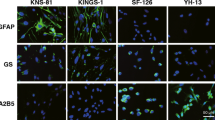Abstract
The present article shows for the first time that two cell lines derived respectively from a rat glioma (C6 cell line) and from a human astrocytoma (1321N1 cell line) are able to convert testosterone and progesterone into their corresponding 5α-reduced metabolites dihydrotestosterone and dihydroprogesterone. Moreover, both cell lines are also able to convert these metabolites further into their corresponding 3α-OH derivatives, 5α-androstan-3α, 7β-diol (3α-diol) and tetrahydroprogesterone. On the basis of these observations, the possibility that secretory products of normal and tumoral brain cells might be able to influence steroid metabolism occurring in the two glial cell lines previously mentioned as well as in fetal rat neurons and in neonatal rat type 1 astrocytes has been considered. To this purpose, cultures of the different cellular types have been exposed to the conditioned medium in which the other cells were grown. The results obtained indicate that:
-
1.
Neurons are able to stimulate, in a statistically significant fashion, the formation of dihydrotestosterone (DHT), 3α-diol, and tetrahydraprogesterone (THP) in C6 cells.
-
2.
Type 1 astrocytes, on the contrary, are unable to modify steroid metabolism in C6 cells.
-
3.
C6 cell product(s) decrease(s) the formation of DHP in type 1 astrocytes, without modifying that of DHT.
-
4.
C6 cells do not influence the metabolism of testosterone (T) and progesterone (P) in neurons.
In conclusion, the present observations show that the conditioned medium of normal neurons is able to increase the metabolism of testosterone and progesterone occurring in a tumoral glial cell line, and that the conditioned media of the two tumoral cell lines analyzed are able to decrease the conversion of P into DHP occurring in normal type 1 astrocytes. The surprising result that these conditioned media do not alter the formation of DHT is discussed. Work is presently in progress to identify the principle(s) responsible respectively for the activating and inhibiting actions here described.
Similar content being viewed by others
References
Melcangi, R. C., Celotti, F., Castano, P., and Martini, L. (1993). Endocrinology 132, 1252–1259.
Melcangi, R. C., Celotti, F., and Martini, L. (1994). Brain Res. 639, 202–206.
Melcangi, R. C., Celotti, F., and Martini, L. (1994). Endocrine 2, 709–713.
Celotti, F., Melcangi, R. C., and Martini, L. (1992). Frontiers in Neuroendocrinology 13, 163–215.
Melcangi, R. C., Celotti, F., Castano, P., and Martini, L. (1992). Brain Res. 585, 411–415.
Sharma, S. K. and Raj, A. B. J. (1987). J. Neurosci. Res. 17, 135–141.
Ségovia, J., Lawless, G. M., Tillakaratne, N. J. K., Brenner, M., and Tobin, A. J. (1994). J. Neurochem. 63, 1218–1225.
Andersson, S. and Russell, D. W. (1990). Proc. Natl. Acad. Sci. USA. 87, 3640–3644.
Levy, M. A., Brandt, M., Sheedy, K. M., Holt, D. A., Heaslip, J. I., Trill, J. J., et al. (1965). J. Steroid Biochem. Molec. Biol. 52, 307–319.
Russel, D. W., Berman, D. M., Bryant, J. T., Cala, K. M., Davis, D. L., Landrum, C. P., et al. (1994) Recent Prog. Horm. Res. 49, 275–284.
Melcangi, R. C., Froelichsthal, P., Martini, L., and Vescovi, A.L. (1996). Neuroscience 72, 467–475.
Lephart, E. D. (1993) Mol. Cell. Neurosci. 4, 473–484.
Lephart, E. D. (1993) Mol. Cell. Neurosci. 4, 526–531.
Melcangi, R. C., Riva, M. A., Fumagalli, F., Magnaghi, V., Racagni, G., and Martini, L. (1996). Brain Res. 711, 10–15.
Laping, N. J., Teter, B., Nichols, N. R., Rozovsky, I., and Finch, C. E. (1994). Brain Pathol. 1, 259–275.
Riol, H., Fages, C., and Tardy, M. (1992). J. Neurosci. Res. 32, 79–85.
Toda, M., Miura, M., Asou, H., Toya, S., and Uyemura, K. (1994). J. Neurochem. 63, 1975–1978.
Wolff, J. E., Laterra, J., and Goldstein, G. W. (1992). J. Neurochem. 58, 1023–1032.
Jung-Testas, I., Renoir, M., Bugnard, H., Greene, G. L., and Baulieu, E.-E. (1992). J. Steroid Biochem. Mol. Biol. 41, 621–631.
Davis, C. (1990). Eur. J. Cancer 26, 859,860.
Grunberg, S. M., Weiss, M. H., Spitz, I. M., Ahmadi, J., Sadun, A., Russel, C. A., et al. (1991). J. Neurosurg. 74, 861–866.
Melcangi, R. C., Celotti, F., Ballabio, M., Castano, P., Massarelli, R., Poletti, A., et al. (1990). Brain Res. 516, 229–236.
Bradford, M. M. (1976). Ann. Biochem. 72, 248–254.
Author information
Authors and Affiliations
Corresponding author
Rights and permissions
About this article
Cite this article
Melcangi, R.C., Cavarretta, I., Magnaghi, V. et al. Crosstalk between normal and tumoral brain cells. Endocr 8, 65–71 (1998). https://doi.org/10.1385/ENDO:8:1:65
Received:
Revised:
Accepted:
Issue Date:
DOI: https://doi.org/10.1385/ENDO:8:1:65




